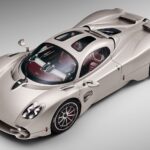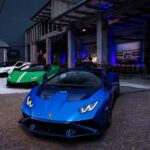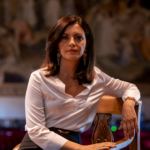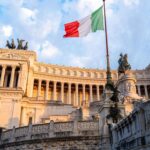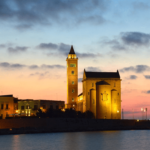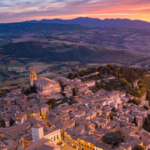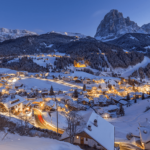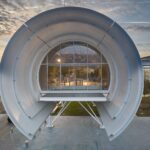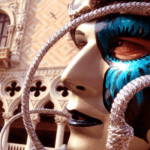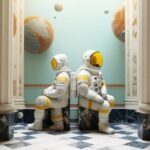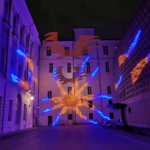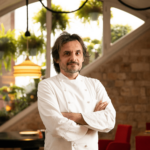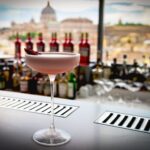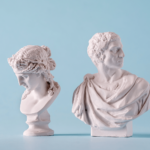Visionaries, frequently branded as multipotentialites, are all endowed with the unique ability to pursue different endeavours seamlessly. When we hear of their larger-than-life pursuits, it is instructive to look at how they embraced and were successful in the first place—particularly in a culture that prioritizes the specialist, the expert, the so-called best in class in one particular area. The founder of Hyperloop Italia, Bibop Gresta, is one such visionary. His vast range of talents and interests make his skillset impossible to fit into one proverbial box: DJ, Entertainer, Self-taught programmer leading a Canadian multinational at only 15 years old, Venture Capitalist, Pioneer in supersonic-speed transportation capsules– there is little the Tuscan native hasn’t attempted in half a century. This interview is yes about the future of travel, but it is also a journey into the mindset of a visionary. An attempt to extract the principles that separate a passive observer from the active doer trying to make a difference in this world.

PART 1: EARLY LIFE
By twelve years old, Bibop had become an accomplished programmer and musician. Seeing his son for the prodigy that he was, his father struck a deal with the wildly curious boy: Bibop could use the computer, even offering to finance a database programming course at IBM, in exchange for help with his business management applications. Bibop jokingly calls the arrangement “underhanded blackmail.” By 16, Bibop quickly established himself as both a programmer and DJ. He recorded twenty-one records in six years while founding BIBOP—a new-media incubator and Italy’s first cross-media agency. In 1998, at the dawn of the Internet. Telecom, now TIM S.p.A., Italy’s largest telecommunications service provider, set its sights on Bibop’s start-up purchasing forty percent of the company for 11 billion lire.

GIOVANNA: Where did the name BIBOP come from?
BIBOP: It came from my mother. She was listening to jazz music when I was young. She was really sad at the time, but she was only happy when she put on this kind of music. She nicknamed me Bebop and I imagined it spelled B-I-B-O-P the Italian way. And it stuck!
GIOVANNA: In your best-selling book “Hyperloop: History and Technology Of The 1,223 Km/h Capsule That Will Revolutionise The World Of Transport”, you talk about getting your hands on your father’s computer—A thing you were explicitly told not to touch.
BIBOP: I was just a child, and my father bought a computer and a keyboard. He said, “Do whatever you want, but don’t touch that computer or keyboard!”
It became an obsession.
That was the first big NO of my life.
There was a ladder to climb to enter this magical room where the magic was happening. It was an escape and a big learning curve because it was forbidden. I had a limited time to read the code in this English magazine. I had to decode what was written in there and then copy it, and by typing RUN, you can see the results of all this code, and for me, it was magic!
I later discovered that you could change results by changing parameters. That’s when the fun began!
GIOVANNA: At 15 you were supervising the software development arm of a multinational Canadian company— You’re looking at me like this is a normal thing—but you do realize it’s not normal, right?
BIBOP: (Laughing) It was instrumental because it was really pushing me to get more responsibility. I became the head of business programming for a multinational when I was a kid (reflective pause), coordinating real engineers.

PART 2: EVOLUTION
GIOVANNA: Then came Digital Magics, an incubator for innovative high-tech start-ups
BIBOP: I love Italy. At the time, we represented 20% of the Italian innovation market through Digital Magics, the incubator I founded. Not because I’m cool but because the Italian innovation market sucks.
GIOVANNA: Still or then?
[Deep pause]
BIBOP: Whatever! (Laughing) BEEP!
GIOVANNA: What is the difference between passion and curiosity?
BIBOP: So for a kid before following their passion, they need to discover who they are and what makes them vibrate. Your curiosity should drive you. Go out and discover the world, especially beginning in the first 30 years. Please don’t be passionate. Be curious.
GIOVANNA: What advice would you give to students of any age?
BIBOP: Go around the world. Discover different things because the passion will lead you to your comfort zone, something you feel like you really belong, and usually, it’s created by something else that is not you. If you follow your curiosity, you’re open to discovering new things, and then when you find out where you vibrate, you can become passionate but never stay still. Change a lot!
GIOVANNA: In defining one’s career path, you said something unexpected. You said Don’t be —
BIBOP: Don’t be passionate! Be curious! We live in a world where false stimuli bombard us. They create an entire market out of creating a false need. So you feel like you are passionate about something because you saw a subtle advertisement somewhere, and now all of a sudden, you’re a squash player, but in reality, you don’t know what you really need in this kind of environment.
PART 3: BRIDGING ART & SCIENCE

“Our society has placed the artist and the scientist at opposite ends of the spectrum.”
— Bibop Gresta
GIOVANNA: You have been successful in both technical and artistic pursuits. But you refuse to be called an expert in anything.
BIBOP: Success is not measured by being the best. It usually means to have decrypted the topic. So usually, the number one of something is not the best at that particular discipline. Don’t believe in experts.
Sign up for the LF Italy newsletter
Access The Rare and Wonderful, LF Italy’s monthly newsletter. Get our latest interviews and discoveries in wellness, travel, innovation, food & drink, unique stays and more.
GIOVANNA: Why?
BIBOP: Because we are in such an expanded knowledge society where you can’t be an expert, it’s impossible because something new comes into the market as soon as you learn something new. If you say you’re the best, you stick to something vertically. You decrypted the algorithm to become number one, but number one only means one thing: You slipped through the cracks.
GIOVANNA: In your book, you talk about the polarization between arts and science. You have been successful at marrying the two.
BIBOP: When I talk about arts and science, I refer to the fact that I was able to decode the world of art by having successful records and tv shows and design technologies that were successful. Still, in reality, there is no difference between the two. Artists and scientists are the same.
GIOVANNA: In what way?
BIBOP: Is Leonardo Da Vinci a painter or a scientist?
An artist in the 15th century was a scientist. Unfortunately, then some crazy thing happened. Sometimes history plays some strange tricks on us. The people who were paying artists were mainly the church. They were the ones who commissioned the art. When the artists that were scientists started to understand science, saying wait a minute, maybe the earth isn’t the centre of the universe, the commissioner didn’t like that. So do you want to tell the truth about science or stay an artist? There was a big split between the two, and it’s crazy that in our universities, we divide science and art like two antagonists, which was the biggest crime we committed to culture.
GIOVANNA: How can we, or can we, fix this?
BIBOP: We must reform the university and rethink critical thinking, starting with the kids. That would be the most important thing. The first biggest mistake is our identity. We should throw away our identity. If you identify with something, take it and burn it in the beautiful pit of the mass market.
BIBOP: How did you do that?
I did it because I did not recognize myself in anything or anyone. So that was easy for me because I needed my own thing. I was Bibop.
PART 4: a NEW LIFE
“After twenty years of living as a super hamster, I needed something new to make sense of my existence. I dreamed of finding an idea that could change the world.”
— Bibop Gresta
After listing Digital Magics on the stock exchange with great success and following the birth of more than thirty start-ups and having been on the board of a couple of listed companies in Europe, in 2013, something changed.
GIOVANNA: At a certain point, you had enough of Venture Capital and felt it was time for a new life —in California.
BIBOP: It was my fortieth birthday. I had the American dream and i said. If i don’t do it now, I will never do it. But it was like being in Italy. I would sit at a cafe where a random Italian start-upper would recognize me and pitch me the next big thing in coffee making. I had had enough of venture capital. But when you reject something, sometimes life pushes you in the right direction.
PART 5: THE HYPERLOOP REVOLUTION
Today, Bibop is one of the key global players in a visionary project proposed by Tesla and Space X CEO Elon Musk, who, never pursuing it personally, launched it as an open-source business opportunity and ignited a Call To Action to anyone wanting to develop the supersonic capsule. A spark that quickly caught fire. Entrepreneurs and companies worldwide picked up the call to turn the idea into a reality. Among them was Dirk Ahlborn, a Berlin-born entrepreneur and investor living in the United States, co-founder and CEO of Jumpstarter, a company that developed the crowdsourcing platform JumpStartFund, based in El Segundo, California.

GIOVANNA: You mention in the book how Dirk was the man who knew “how to turn a ‘No’ into an opportunity”
BIBOP: This German guy was introduced to me at M.E.T.A.L. He started to pitch me a start-up about Elon Musk. I destroyed it. I said, your pitch is Caption a disaster. You’re delusional. Anything you can do to make a VC run, he did it. But that could have been the end of it. But he was really stubborn.
GIOVANNA: Your car is at the shop until you are scheduled for an investor retreat. You needed a ride, and Dirk was ready and willing to give you a ride. And you’re like —
BIBOP: SHIT! In reality, in that hour, he was so humble to explain the concept of crowdsourcing. It was interesting and not so crazy anymore, so I read his document created by more than 100 scientists working on this through crowdsourcing: giving their time in exchange for shares. I became fascinated. For two months, I didn’t do anything else. It became an obsession. I started to look at the Hyperloop with different eyes, and it became clear that it was doable.
GIOVANNA: What did you want out of this Hyperloop?
It was the moment for me to do something meaningful that was impacting millions of people. It was leaving a legacy that was the most important thing to me. I was all in.
GIOVANNA: Every good story has an obstacle. Your book discusses the numerous obstacles you faced on this Hyperloop journey. Did you ever have a moment where you thought, I’m over my head—Why not move on?
The beauty of what I did is that I did it at the right moment. I already had my success and failure. I was stubborn enough to say you need to shoot me in the head to stop me.
PART 6: 4IR
“The First Industrial Revolution dates to the early 1800s in the United Kingdom, when British inventors perfected a steam engine that could move an entire carriage. Then, the first railway system was born, and the first large-scale working steam railway was built, connecting Liverpool to Manchester. The Second Industrial Revolution originated between 1870 and 1914 in Detroit when some inventors perfected the Ford engine using an internal combustion engine with liquid fuel. This started a brand-new automobile industry. The Third Industrial Revolution took place in 1950 in Silicon Valley (California), when some technology pioneers created the first microchip, revolutionizing the world with the personal computer.”
— Bibop Gresta
GIOVANNA: We are currently in the era of the Fourth Industrial Revolution—What does that mean exactly? And how does Hyperloop fit into it?
BIBOP: The Fourth Industrial Revolution has yet to be identified. 4IR doesn’t have a place or a technology. The Hyperloop will generate a new generation of infrastructure designed with different principles.
GIOVANNA: What is the principle?
The principle is to give back more than you take. And that’s why I say be energy positive because we can generate more electricity than we can consume. It’s a new way of looking at infrastructure— a new way to respect the planet, taking less than what you give.
GIOVANNA: This sounds like sustainability—
BIBOP: Yes, but sustainability as a design criterion, not as a plug-in, and we can do it. We have the technology. The beauty of it is that it makes sense economically. It makes sense logistically. It makes sense for everything.
GIOVANNA: There is a movement toward human centricity–putting humans at the centre. But a lot of people are afraid about the future—
BIBOP: Don’t.
GIOVANNA: And that AI is taking all of our jobs—
BIBOP: And this is good. This is ok! Undoubtedly, 50% of the jobs by 2050 will be gone, which is why we created technology. I’m a transhumanist. Technology will improve our life. And when you don’t have to struggle because you have to work at a 9-to-5 job that you probably dislike or are in a rat race. So it’s beautiful that there will be machines that will take out 80-90% of the struggle. You can create. You can be yourself. And we will go back to what we do best: Thinking, creating, enjoying, and giving life meaning.
PART 7: Does Italy Have a Future?
“Italy was not on our radar, and with the red tape and bureaucracy, the bel paese had inexorably slipped into “Phase Two.” Usually, when an idea ends up in “Phase Two,” it is like being locked in a time capsule, kept in a state of cryogenic suspension. His vital functions remain active, but his body falls into a state of apparent death, heading into the future. It waits for someone with magical technology to one day reanimate it and bring it back to life.”
— Bibop Gresta
The most recent phase in Bibop’s evolution begins with his (risky!) return to Italy. Until 2019, Bibop was the co-founder and chairman of Hyperloop Transportation Technologies (later renamed HyperloopTT). He stepped down as chairman of the California-based HyperloopTT while retaining his shares. He then moved back to Italy to launch Hyperloop in Italy, where he is committed to disseminating and implementing Hyperloop technologies and next-generation infrastructure. Bibop’s primary motivation? Veneto. In 2018, the president of the Veneto region, Luca Zaia, and the CEO of CAV-Veneto Motorway Concessions, Ugo Dibennardo, visited Bibop in California with the goal of building the first Hyperloop in Veneto. In fact, in March 2022, much emphasis was placed on signing a memorandum of understanding between the CAV, the Veneto region, and the Ministry of Infrastructure, aiming to assess the feasibility Caption of the project. Bibop intends to participate in the bid with his Hyperloop Italia and Hyperloop TT.
GIOVANNA: Do you think Italy has a future?
BIBOP: Italy has a future. It is like Cinderella.
Historically, it originated all the great revolutions—the Renaissance started here. The beauty of invention started somehow connected to what Italians have done. Even modern civilization was based on it. So I think Italy can leapfrog. We have undiscovered talents, and we have a contextual possibility that can favor a new generation of transportation that is sustainable, efficient, and fast. And this is the Hyperloop.
—Last Question—
GIOVANNA: Can you leave us with your picture of the future?
BIBOP: The future is a beautiful combination of nature and high-tech. The more we evolve as humans, the more we will look like nature. We are just evolving as a species and will become multi- planetary species, returning to the roots. Understanding our origin will create and shape our future. That’s why I say look at the past to create the future.

